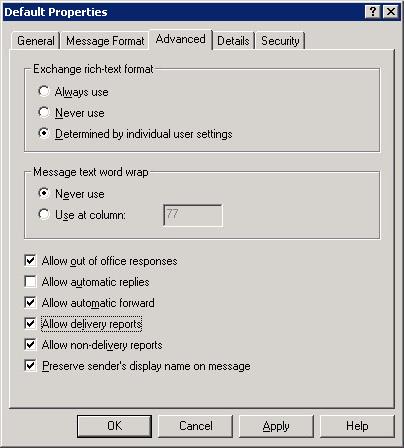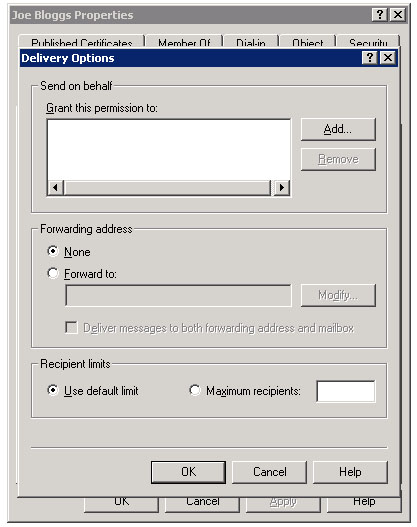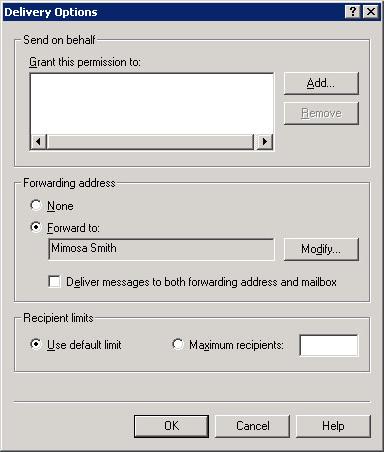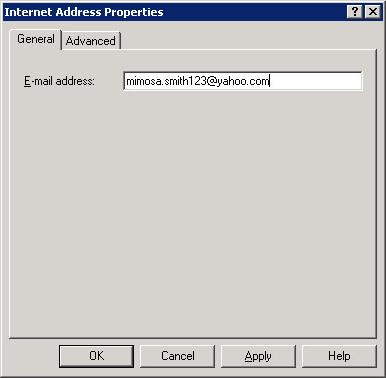Browse All Articles > Forward Email to External Email Address - Exchange 2003
Sometimes, having the ability for a user to forward their email to another user in the organization, or indeed outside the network, is important. Ignoring the legal issues of having company information immediately forwarded to another user, the procedure is relatively easy and safe to configure, with the only issue an increased chance of a mail loop occurring.
For the purposes of this article, I have initially created two user accounts in my Active Directory structure: Joe Bloggs and Mimosa Smith. Both accounts are standard accounts on a Windows Server 2003 network, with Exchange 2003 mailboxes and external email addresses.![User Accounts created in Active Directory]()
![Enable Message Forwarding on a global level]()
In order for us to forward all Joe's mail to Mimosa, we need to edit the properties on Joe's account. So, pull down the right-click menu on his user account, and choose Properties. You will now be presented with the standard properties dialog for Joe Bloggs's user account. To configure the forwarding element, we need to switch to the Exchange General tab, and then click the Delivery Options button. The Delivery Options dialog box will open.![The Delivery Options dialog box]()
Under the 'Forwarding address' section, choose the 'Forward to' option, which will enable the Modify button. We can then press 'Modify' and choose Mimosa Smith from Active Directory. The 'Delivery Options' dialog box should now appear as shown below. If it does, the forwarding is setup and configured.![Internal forwarding to an internal mailbox (configured)]() Note: For the purposes of this example, I have opted not to check the checkbox below 'Mimosa Smith'. This feature is only applicable in some cases; in this case, since nobody will be checking Joe Bloggs' mailbox on a regular basis, and it will fill up as a result.
Note: For the purposes of this example, I have opted not to check the checkbox below 'Mimosa Smith'. This feature is only applicable in some cases; in this case, since nobody will be checking Joe Bloggs' mailbox on a regular basis, and it will fill up as a result.
Finally, you should test the configuration from both an internal and external mailbox, to verify it is actually working.
The first issue you will face is the inability to follow the Internal > Internal forwarding method above. An email address cannot be entered directly into the Delivery Options section. Instead, we need to create a Contact object in Active Directory, and enter the user's External Email Address for forwarding mail to here. For the purposes of this article, we will now be forwarding Mimosa Smith's email to her external Yahoo! email account.
First, you need to create the Contact object. This is very easy to achieve: right-click in Active Directory Users and Computers, choosing the New menu. Select the 'Contact' item from the list. Enter the appropriate information on the first page. I suggest you keep the First Name, Last Name and Display Name the same as the user account is configured. However, the Full Name could cause some issues, since it may automatically be created as 'Mimosa Smith', causing a clash with the existing Mimosa Smith user account in Active Directory. Append something, such as (Personal Email Address) or (Contact) to the Full Name to make it unique. When all looks correct, click Next to move on. If there is an issue (the most likely being a clash in the Full Name field), you will be notified of this before you can proceed.
On the next page of the wizard, you are now prompted to create an Exchange Email Address. Remember that when creating a contact, no mailbox is created, and no login is created for the contact account. It is simply a placeholder which maps an internal Active Directory object to an external email address. Pressing the Modify button on this page enables you to choose the 'SMTP address' option, and enter the user's personal external email account to which the email will be forwarding to.![Entering the external SMTP email address into the Contact]() You can now complete the wizard.
You can now complete the wizard.
The final stage is now easy: Following the steps for an internal > internal forward (section 1, above), you simply press the 'Modify' button on the main user account's Exchange properties, and specify the Contact object as the location to forward to. Job done.
In this case, using the information we have learned above. The procedure should be easy. Firstly, create a Security Group in Active Directory (yes, a Security Group), and make the recipients of the forwarded mail members. Mail-enable the group by right-clicking on it and using the options under 'Exchange Tasks'. If you need to forward to external users, create contact objects as shown above, and make them members of the group. Now, it is simply a case of using the 'Delivery Options' dialog, as detailed in Step 1, to configure the user account with a forwarding location of the new Security Group.
As shown, Exchange forwarding is more powerful than is initially thought, and a lot can be achieved with it.
-Matt
For the purposes of this article, I have initially created two user accounts in my Active Directory structure: Joe Bloggs and Mimosa Smith. Both accounts are standard accounts on a Windows Server 2003 network, with Exchange 2003 mailboxes and external email addresses.

1. Enable Forwarding at a Global level
Firstly, no matter whether you will be forwarding email using an Outlook rule, or using any form of forwarding server-side, the feature must be enabled on the Exchange 2003 Server(s) by the mail administrator. This is performed by opening Exchange System Manager, drilling down to the Global Settings and then Internet Message Formats option. Within the Message Formats container, choose your message format(s) (probably the Default one, unless you have modified this), and view their properties. On the Advanced tab, check the box marked 'Allow automatic forward'.
2. Internal Forwarding
Take an example:Joe Bloggs has left the company, and we need his replacement, Mimosa Smith, to receive all Joe's email for the foreseeable future.This is a perfectly plausible issue, and while we could use features such as attaching Joe's mailbox as an additional mailbox to Mimosa's account, it does not overcome the possibility of her forgetting to check his account on a routine basis. Thus, we need forwarding:
In order for us to forward all Joe's mail to Mimosa, we need to edit the properties on Joe's account. So, pull down the right-click menu on his user account, and choose Properties. You will now be presented with the standard properties dialog for Joe Bloggs's user account. To configure the forwarding element, we need to switch to the Exchange General tab, and then click the Delivery Options button. The Delivery Options dialog box will open.

Under the 'Forwarding address' section, choose the 'Forward to' option, which will enable the Modify button. We can then press 'Modify' and choose Mimosa Smith from Active Directory. The 'Delivery Options' dialog box should now appear as shown below. If it does, the forwarding is setup and configured.
 Note: For the purposes of this example, I have opted not to check the checkbox below 'Mimosa Smith'. This feature is only applicable in some cases; in this case, since nobody will be checking Joe Bloggs' mailbox on a regular basis, and it will fill up as a result.
Note: For the purposes of this example, I have opted not to check the checkbox below 'Mimosa Smith'. This feature is only applicable in some cases; in this case, since nobody will be checking Joe Bloggs' mailbox on a regular basis, and it will fill up as a result.
Finally, you should test the configuration from both an internal and external mailbox, to verify it is actually working.
3. Internal to External Forwarding
In some cases, forwarding to an internal mailbox is not the ultimate objective. It is quite common for an IT department to receive requests from users asking if they are able to have all email forwarded to a personal email account, such as a Yahoo! mailbox. While you should do your very best to have the user make use of Outlook Web Access or RPC over HTTPS, the preferred, organized method for remote access to mail, there are some exceptions to this rule.The first issue you will face is the inability to follow the Internal > Internal forwarding method above. An email address cannot be entered directly into the Delivery Options section. Instead, we need to create a Contact object in Active Directory, and enter the user's External Email Address for forwarding mail to here. For the purposes of this article, we will now be forwarding Mimosa Smith's email to her external Yahoo! email account.
First, you need to create the Contact object. This is very easy to achieve: right-click in Active Directory Users and Computers, choosing the New menu. Select the 'Contact' item from the list. Enter the appropriate information on the first page. I suggest you keep the First Name, Last Name and Display Name the same as the user account is configured. However, the Full Name could cause some issues, since it may automatically be created as 'Mimosa Smith', causing a clash with the existing Mimosa Smith user account in Active Directory. Append something, such as (Personal Email Address) or (Contact) to the Full Name to make it unique. When all looks correct, click Next to move on. If there is an issue (the most likely being a clash in the Full Name field), you will be notified of this before you can proceed.
On the next page of the wizard, you are now prompted to create an Exchange Email Address. Remember that when creating a contact, no mailbox is created, and no login is created for the contact account. It is simply a placeholder which maps an internal Active Directory object to an external email address. Pressing the Modify button on this page enables you to choose the 'SMTP address' option, and enter the user's personal external email account to which the email will be forwarding to.
 You can now complete the wizard.
You can now complete the wizard.
The final stage is now easy: Following the steps for an internal > internal forward (section 1, above), you simply press the 'Modify' button on the main user account's Exchange properties, and specify the Contact object as the location to forward to. Job done.
4. Forwarding to multiple users
Finally, a common question is how to have a generic email address forward mail to multiple users. There are two methods by which this can be achieved. My preferred is to use a distribution group, making the recipients of forwarded mail members of the group and then ensuring the group has the correct email address assigned. However, there are times when the forwarding must be from a user account to multiple users.In this case, using the information we have learned above. The procedure should be easy. Firstly, create a Security Group in Active Directory (yes, a Security Group), and make the recipients of the forwarded mail members. Mail-enable the group by right-clicking on it and using the options under 'Exchange Tasks'. If you need to forward to external users, create contact objects as shown above, and make them members of the group. Now, it is simply a case of using the 'Delivery Options' dialog, as detailed in Step 1, to configure the user account with a forwarding location of the new Security Group.
As shown, Exchange forwarding is more powerful than is initially thought, and a lot can be achieved with it.
-Matt
Have a question about something in this article? You can receive help directly from the article author. Sign up for a free trial to get started.


Comments (23)
Commented:
Commented:
Commented:
The categorizer will queue one copy to exchange mailbox and other one to external account.
but which account is responsible for sending? its the users account or system account in exchange?
Commented:
Now I have added Google Apps into the equation, and I am having issues getting this to work. I have always setup this process as it shows above. Now the dynamic is a bit different but same concept.
All incoming mail is directed to Google Apps for Spam filtering and then forwarded on to my exchange and the header is marked as spam or not. From there I have setup Contact (same as above) and setup forward (same as above). The email just never shows up in the forwarded email address. I have tried several different types of internet mail and all have the same result. The email just never shows up. No NDR, no error, no nothing.
Any help would be great.
I was thinking it could be DNS, but not sure.
Commented:
Exchange Standard 2003 SP1 hosted on Server 2003 SP2.
Same server is hosting internal DNS with internet forwarders.
View More